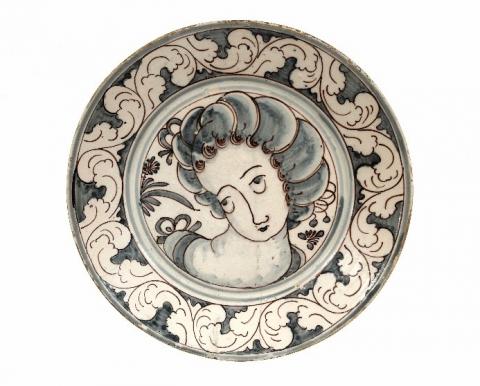Prato de Grandes Dimensões
Faiança portuguesa, Faixa Barroca
Lisboa, 1680-1690
Dim.: 39,0 cm
Prov.: Coleção Maldonado de Freitas, Lisboa
Large Plate
Portuguese faience “Baroque band”
Lisbon, 1680-1690
Dim.: 39,0 cm
Prov.: Maldonado de Freitas collection, Lisbon
Large tin-white glazed Portuguese faience shallow plate of broad sloping lip, decorated with “Baroque band” and resting on a discreet ringed foot. For its evident pictorial power and strong aesthetic impact it represents a fascinating example of this production.
The decorative composition adopts painted motifs in cobalt-blue pigment, of various dilutions or nuances – chromatic densities of a colour, and fine and precise manganese-oxide for highlighting and empowering the design.
In the centre a stately female bust with headdress and rounded neckline, clearly influenced by Italian majolica, and simple foliage elements in evident Chinese taste. This “Bella”, her head leaning towards the right shoulder and with feminine, languid and simulated gaze, characteristic of the era and simultaneously seductive, features sophisticated hairstyling, adorned with bows that allude to the painted scrolls seen in porcelain decoration from Emperor Wanli’s reign (1573-1617).
This central circular frame is delimited by a double fillet that isolates it from the lip, decorated with an imposing Baroque band that conveys musicality, through the rhythmic volutes that follow an undulating pattern guiding and directing them. This foliage decoration of continuous scrolls, together with the Bella’s leaning head, confers great dynamism to this exceptional faience plate.
On the reverse the ink handwritten inventory reference CMF 0269.
It is essential to highlight the 1600s Portuguese Artist mastery in reinterpreting the vast Chinese porcelain imaginary. These potters were never copiers; on the difficult support of the bisque fired ceramics, they recreated with considerable input from their own resourceful imagery.
Prato de grandes dimensões, em faiança portuguesa de covo acentuado, aba larga e levantada, assente em pequeno frete recuado e coberto de esmalte branco com decoração dita de faixa barroca, constituindo um fascinante exemplar desta produção pela sua força pictórica e impacto estético.
A decoração, usa pintura em azul-cobalto de diferentes diluições ou nuances - intensidades cromáticas na mesma côr - e traço fino e preciso, que contorna e reforça todo o desenho desta composição, em vinoso.
O fundo é preenchido por um majestoso busto feminil, de cabelo envolto em toucado e decote redondo, de nítida influência da majólica Italiana, com singelos elementos vegetalistas ao gosto chines. Esta “Bella “, com a cabeça inclinada sobre o ombro direito e olhar feminino, languido, simulado, característico da época e sedutor ao mesmo tempo, tem o cabelo preso com laçaria que remete para as fitas dos rolos de pintura da porcelana Wanli (1573-1617).
Esta reserva circular é circunscrita por duplo filete, que a separa da aba larga, decorada por faixa barroca, visualmente bem presente. Esta barra apresenta alguma musicalidade, com volutas ritmadas, que seguem uma ondulação que as guia e dirige. Esta decoração vegetalista com enrolamentos contínuos, juntamente com a inclinação da cabeça da Bella, confere um grande dinamismo à peça.
No verso não decorado com número de inventário CMF 0269.
É de referenciar a mestria de um Homem Artista seiscentista, português que reinterpreta o vasto imaginário da porcelana chinesa. Estes oleiros nunca copiaram: sobre um suporte de pintura difícil, a chacota, recriam dando muito do seu rico imaginário.
- Arte Portuguesa e Europeia
- Azulejos e Faianças

